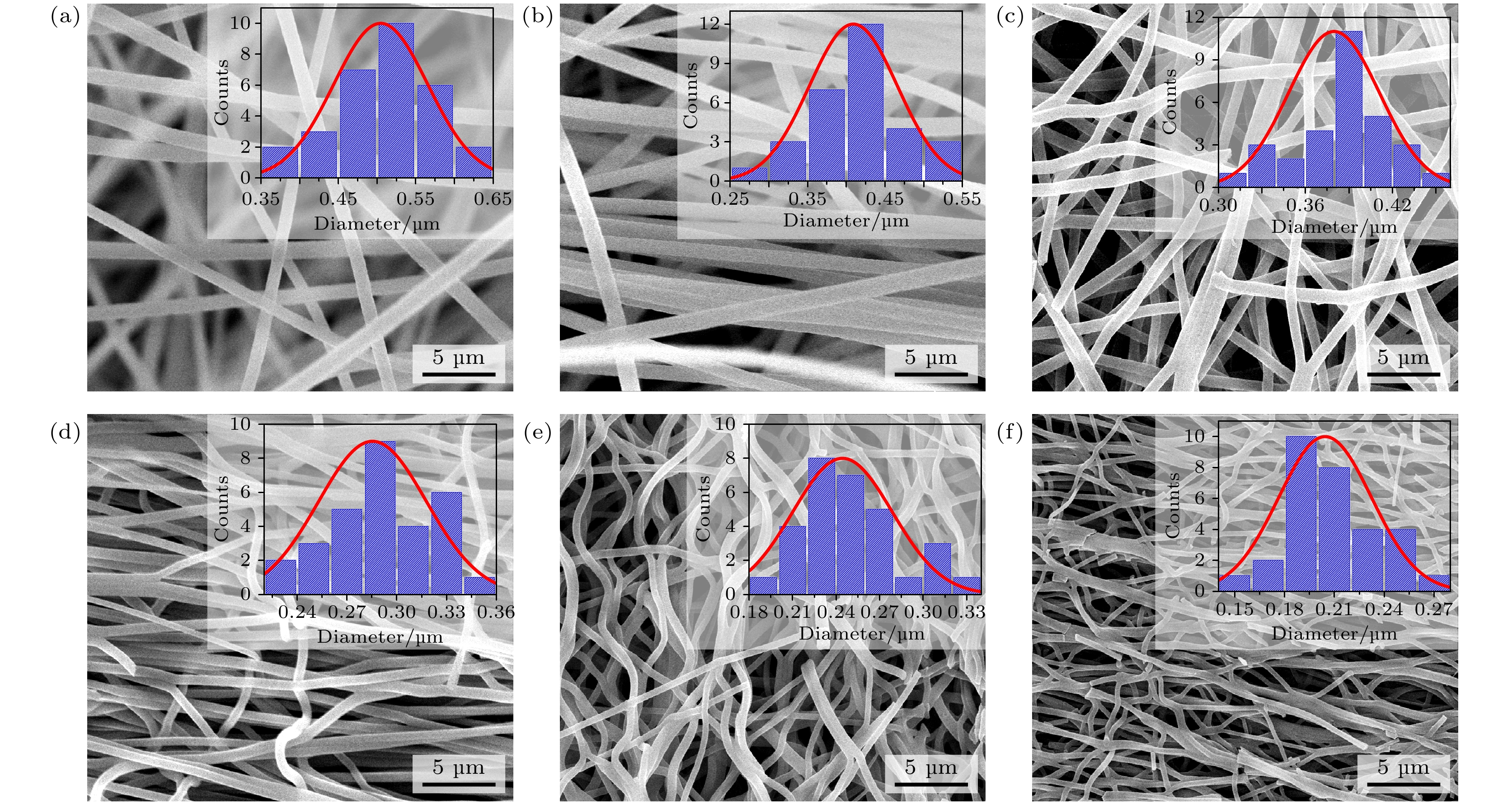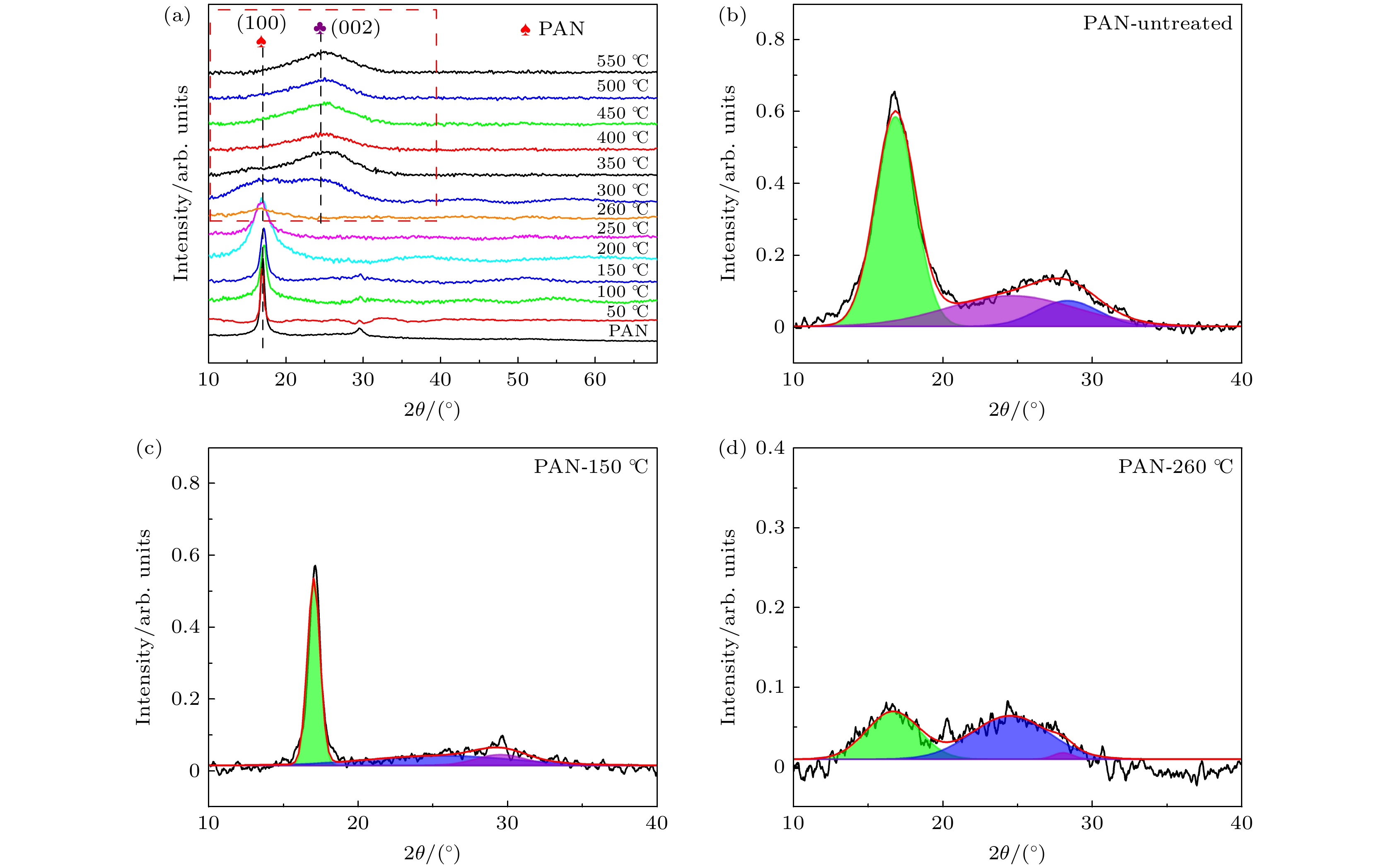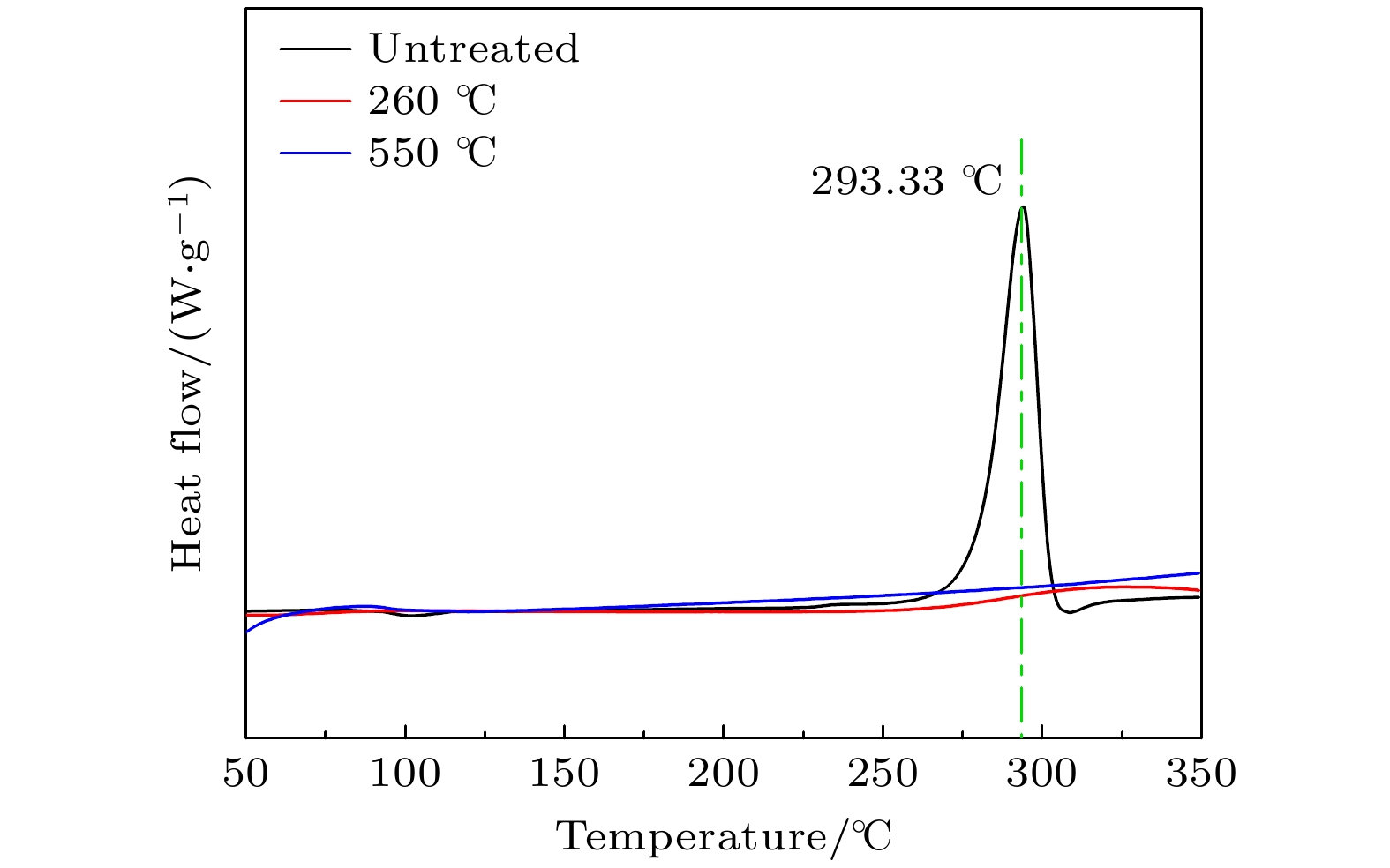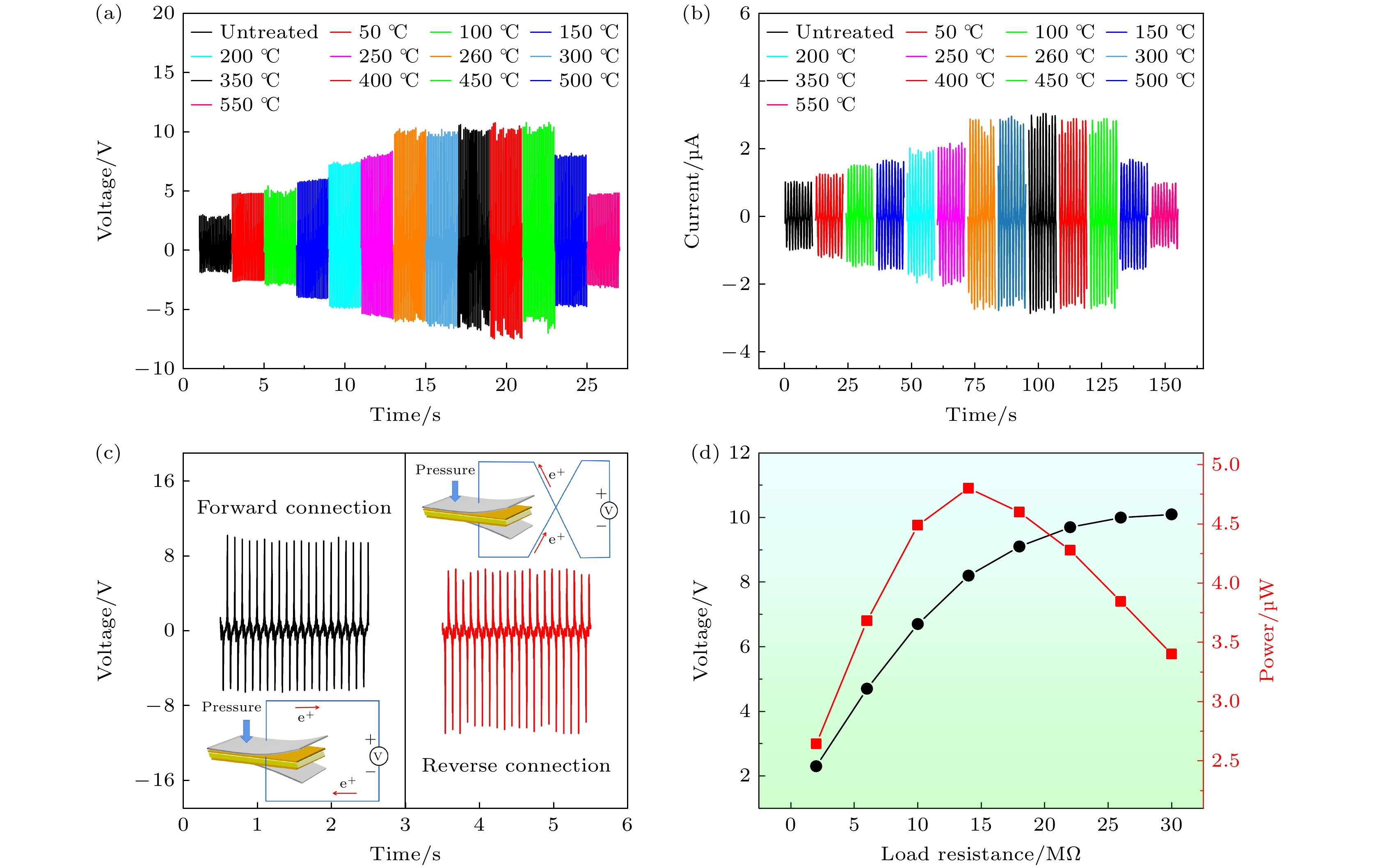-
提高压电聚合物的耐温性, 且构建压电特异结构提高电学输出特性, 成为柔性耐高温压电/热释电双功能传感器制造的关键. 本文采用静电纺丝法制备了聚丙烯腈(PAN)纳米纤维薄膜, 通过程序控温对PAN纳米纤维膜进行热处理得到了耐高温的柔性纤维薄膜. 研究结果表明, PAN耐高温柔性纤维薄膜纳米传感器可以在高温环境(> 500 ℃)中使用, 其输出性能随热处理温度的升高先增大(< 260 ℃)后基本保持不变(260—450 ℃), 最后输出性能减小(> 450 ℃), 当热处理温度达到260 ℃时, 输出电压可达10.08 V, 输出电流达到2.89 μA, 与未进行热处理的PAN膜相比, 其输出电压和电流分别提高了3.54倍和2.83倍. 同时, 该传感器在高温环境下的输出不发生变化. 发现热处理的PAN具有热释电效应, 且热释电输出随着温度梯度的增大而变大. 在5000次的敲击循环测试中, 经过热处理的PAN纳米纤维薄膜传感器具有稳定的输出, 这表明该传感器有望应用在消防安全、航空航天等高温环境中.
-
关键词:
- 聚丙烯腈 /
- 环化 /
- 耐高温柔性纳米纤维薄膜 /
- 压电/热释电双功能传感器
Most of existing piezoelectric polymers have low glass transition temperatures, so they can only operate at lower temperatures (<150 ℃). Once the operating temperature is exceeded, the piezoelectric performance of the device rapidly decreases. At higher temperatures, dense chain motion can interfere with the orientation of dipoles, thus limiting the development of polymer based high-temperature piezoelectric sensors. High-temperature piezoelectric sensor devices are entirely made of inorganic materials, however, inorganic materials are rigid and can only work under small strains. Therefore, enhancing the temperature resistance of piezoelectric polmers and constructing piezoelectric asymmetric structure are the key to fabricating flexible high-temperature resistant piezoelectric/pyroelectric dual functional sensors. In this study, polyacrylonitrile (PAN) nanofiber film is prepared by electrospinning, and then subjected to heat treatment through programmed temperature control. The effects of the different heat-treatment temperatures on the mechanical and electrical performance of PAN nanofiber film are studied systematically, and the results show that PAN high temperature resistant flexible nanofiber film sensors can be used in high temperature environments (>500 ℃). Its output performance is improved with the increase of heat treatment temperature (<260 ℃) and then basically remains unchanged in a temperature range of 260–450 ℃. Finally, the output performance decreases at temperatures higher than 450 ℃. When the heat treatment temperature reaches 260 ℃, the output voltage increases to 10.08 V, and current reaches 2.89 μA. Compared with those of the untreated PAN membranes , its output voltage and current are increase by 3.54 times and 2.83 times, respectively. At the same time, the output of the PAN high temperature resistant flexible nanofiber film sensors is almost unchanged in the high-temperature environments. This is the first time that the pyroelectric effect has been observed in heat-treated PAN nanofiber films and both the open-circuit voltage and short-circuit current have been shown to increase with temperature gradient increasing. Besides, the PAN nanofiber film sensors have durability of more than 5000 cycles at room temperature(25 ℃) even at high temperature (400 ℃). Overall, good flexible, high-temperature resistance, and bifunctional sensing ability make PAN flexible nanofiber film sensors expected to be widely used in high temperature environments such as fire safety, aerospace and other harsh environment.-
Keywords:
- polyacrylonitrile /
- cyclization /
- high-temperature flexible nanofiber films /
- piezoelectric/pyroelectric bifunctional sensor
[1] Wang Y, Zhang J S, Jia X X, Chen M M, Wang H R, Ji G N, Zhou H Y, Fang Z Z, Gao Z X 2024 Nano Energy 119 109080
 Google Scholar
Google Scholar
[2] 李凤超, 孔振, 吴锦华, 纪欣宜, 梁嘉杰 2021 70 100703
 Google Scholar
Google Scholar
Li F C, K Z, W J H, Ji X Y, Liang J J 2021 Acta Phys. Sin. 70 100703
 Google Scholar
Google Scholar
[3] Hyeon D Y, Nam C, Ham S S, Hwang G T, Yi S, Kim K T, Park K 2020 Adv. Electron. Mat. 7 1
[4] Hyeon D Y, Lee G J, Lee S H, Park J J, Kim S, Lee M K, Park K I 2022 Compos Part B-eng 234 109671
 Google Scholar
Google Scholar
[5] Li Y H, Sun J J, Li P W, Li X R, Tan J Q, Zhang H L, Li T Y, Liang J G, Zhou Y L, Hai Z Y, Zhang J 2023 J. Mater. Chem. A 11 13708
 Google Scholar
Google Scholar
[6] Hosseini E S, Manjakkal L, Shakthivel D, Dahiya R 2020 ACS Appl. Mater. Interfaces 12 9008
 Google Scholar
Google Scholar
[7] Maity K, Mondal A, Saha M C 2023 ACS Appl. Mater. Interfaces 15 13956
[8] Dong L, Lou J, Shenoy V B 2017 ACS Nano 11 8242
 Google Scholar
Google Scholar
[9] Su Y J, Chen C X, Pan H, Yang Y, Chen G R, Zhao X, Li W X, Gong Q C, Xie G Z, Zhou Y H, Zhang S L, Tai H L, Jiang Y D, Chen J 2021 Adv. Funct. Mater. 31 2010962
 Google Scholar
Google Scholar
[10] Jackson N, Mathewson A 2017 Smart Mater. Struct. 26 045005
 Google Scholar
Google Scholar
[11] Tu Y L, Zheng Y, Guo S Y, Shen J B 2022 ACS Appl. Mater. Interfaces 14 40331
 Google Scholar
Google Scholar
[12] Ding W J, Xu W W, Dong Z J, Liu Y Q, Wang Q 2021 Ceram. Int. 47 29681
 Google Scholar
Google Scholar
[13] Khanbareh H, Hegde M, Bijleveld J C 2017 Royal Society of Chemistry 5 9389
[14] Bahl O, Manocha L 1974 Carbon 12 417
 Google Scholar
Google Scholar
[15] Zhang W X, Liu J, Wu G 2003 Carbon 41 2805
 Google Scholar
Google Scholar
[16] Xue Y, Liu J, Liang J Y 2013 Polym. Degrad. Stabil. 98 219
 Google Scholar
Google Scholar
[17] Li Y, Tan J, Liang K, Li Y, Sun J, Zhang H, Luo C, Li P, Xu J, Jiang H, Wang K 2022 J. Mater. Sci. Mater. Electron. 33 4291
 Google Scholar
Google Scholar
[18] Moon S C, Farris R J 2009 Carbon 47 2829
 Google Scholar
Google Scholar
[19] Lian F, Liu J, Ma Z, Liang J Y 2012 Carbon 50 488
 Google Scholar
Google Scholar
[20] Liu Y, Liu Y, Shang L, Ao Y 2022 J. Appl. Polym. Sci. 139 18
[21] Ge Y, Fu Z Y, Zhang M Y, Zhang H X 2021 J. Appl. Polym. Sci. 138 49603
 Google Scholar
Google Scholar
[22] Sun L H, Shang L, Xiao L H, Zhang M J, Ao Y H , Li M 2020 J. Mater. Sci. 55 3408
[23] Wang W Y, Zheng Y D, Sun Y, Jin X, Niu J R, Cheng M Y, Wang H X, Shao H, Lin T 2021 J. Mater. Chem. A 9 20395
 Google Scholar
Google Scholar
[24] Bai S, Xu Q, Gu L, Ma F, Qin Y, Wang Z L 2012 Nano Energy 1 789
 Google Scholar
Google Scholar
[25] Chen C J, Zhao S L, Pan C F, Zi Y L, Wang F C, Yang C, Wang Z L 2022 Nat. Commun. 13 1391
 Google Scholar
Google Scholar
[26] Fu R M, Tu L J, Zhou Y H, Fan L, Zhang F M, Wang Z G, Xing J, Chen D F, Deng C L, Tan G X, Yu P, Zhou L, Ning C Y 2019 Chem. Mater. 31 9850
 Google Scholar
Google Scholar
[27] Korkmaz S, Kariper I A 2021 Nano Energy 84 105888
 Google Scholar
Google Scholar
-
-
[1] Wang Y, Zhang J S, Jia X X, Chen M M, Wang H R, Ji G N, Zhou H Y, Fang Z Z, Gao Z X 2024 Nano Energy 119 109080
 Google Scholar
Google Scholar
[2] 李凤超, 孔振, 吴锦华, 纪欣宜, 梁嘉杰 2021 70 100703
 Google Scholar
Google Scholar
Li F C, K Z, W J H, Ji X Y, Liang J J 2021 Acta Phys. Sin. 70 100703
 Google Scholar
Google Scholar
[3] Hyeon D Y, Nam C, Ham S S, Hwang G T, Yi S, Kim K T, Park K 2020 Adv. Electron. Mat. 7 1
[4] Hyeon D Y, Lee G J, Lee S H, Park J J, Kim S, Lee M K, Park K I 2022 Compos Part B-eng 234 109671
 Google Scholar
Google Scholar
[5] Li Y H, Sun J J, Li P W, Li X R, Tan J Q, Zhang H L, Li T Y, Liang J G, Zhou Y L, Hai Z Y, Zhang J 2023 J. Mater. Chem. A 11 13708
 Google Scholar
Google Scholar
[6] Hosseini E S, Manjakkal L, Shakthivel D, Dahiya R 2020 ACS Appl. Mater. Interfaces 12 9008
 Google Scholar
Google Scholar
[7] Maity K, Mondal A, Saha M C 2023 ACS Appl. Mater. Interfaces 15 13956
[8] Dong L, Lou J, Shenoy V B 2017 ACS Nano 11 8242
 Google Scholar
Google Scholar
[9] Su Y J, Chen C X, Pan H, Yang Y, Chen G R, Zhao X, Li W X, Gong Q C, Xie G Z, Zhou Y H, Zhang S L, Tai H L, Jiang Y D, Chen J 2021 Adv. Funct. Mater. 31 2010962
 Google Scholar
Google Scholar
[10] Jackson N, Mathewson A 2017 Smart Mater. Struct. 26 045005
 Google Scholar
Google Scholar
[11] Tu Y L, Zheng Y, Guo S Y, Shen J B 2022 ACS Appl. Mater. Interfaces 14 40331
 Google Scholar
Google Scholar
[12] Ding W J, Xu W W, Dong Z J, Liu Y Q, Wang Q 2021 Ceram. Int. 47 29681
 Google Scholar
Google Scholar
[13] Khanbareh H, Hegde M, Bijleveld J C 2017 Royal Society of Chemistry 5 9389
[14] Bahl O, Manocha L 1974 Carbon 12 417
 Google Scholar
Google Scholar
[15] Zhang W X, Liu J, Wu G 2003 Carbon 41 2805
 Google Scholar
Google Scholar
[16] Xue Y, Liu J, Liang J Y 2013 Polym. Degrad. Stabil. 98 219
 Google Scholar
Google Scholar
[17] Li Y, Tan J, Liang K, Li Y, Sun J, Zhang H, Luo C, Li P, Xu J, Jiang H, Wang K 2022 J. Mater. Sci. Mater. Electron. 33 4291
 Google Scholar
Google Scholar
[18] Moon S C, Farris R J 2009 Carbon 47 2829
 Google Scholar
Google Scholar
[19] Lian F, Liu J, Ma Z, Liang J Y 2012 Carbon 50 488
 Google Scholar
Google Scholar
[20] Liu Y, Liu Y, Shang L, Ao Y 2022 J. Appl. Polym. Sci. 139 18
[21] Ge Y, Fu Z Y, Zhang M Y, Zhang H X 2021 J. Appl. Polym. Sci. 138 49603
 Google Scholar
Google Scholar
[22] Sun L H, Shang L, Xiao L H, Zhang M J, Ao Y H , Li M 2020 J. Mater. Sci. 55 3408
[23] Wang W Y, Zheng Y D, Sun Y, Jin X, Niu J R, Cheng M Y, Wang H X, Shao H, Lin T 2021 J. Mater. Chem. A 9 20395
 Google Scholar
Google Scholar
[24] Bai S, Xu Q, Gu L, Ma F, Qin Y, Wang Z L 2012 Nano Energy 1 789
 Google Scholar
Google Scholar
[25] Chen C J, Zhao S L, Pan C F, Zi Y L, Wang F C, Yang C, Wang Z L 2022 Nat. Commun. 13 1391
 Google Scholar
Google Scholar
[26] Fu R M, Tu L J, Zhou Y H, Fan L, Zhang F M, Wang Z G, Xing J, Chen D F, Deng C L, Tan G X, Yu P, Zhou L, Ning C Y 2019 Chem. Mater. 31 9850
 Google Scholar
Google Scholar
[27] Korkmaz S, Kariper I A 2021 Nano Energy 84 105888
 Google Scholar
Google Scholar
计量
- 文章访问数: 4936
- PDF下载量: 94
- 被引次数: 0













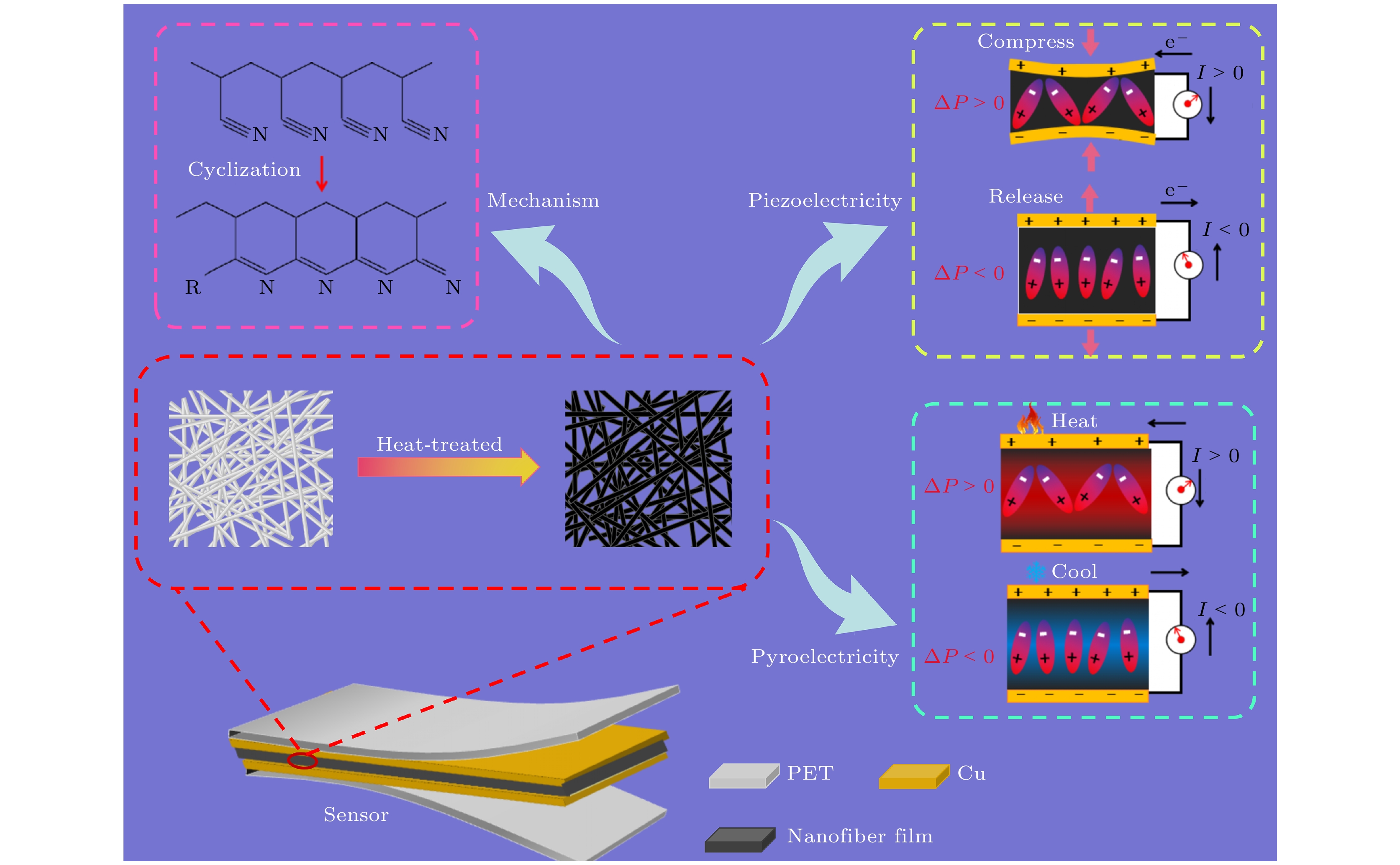
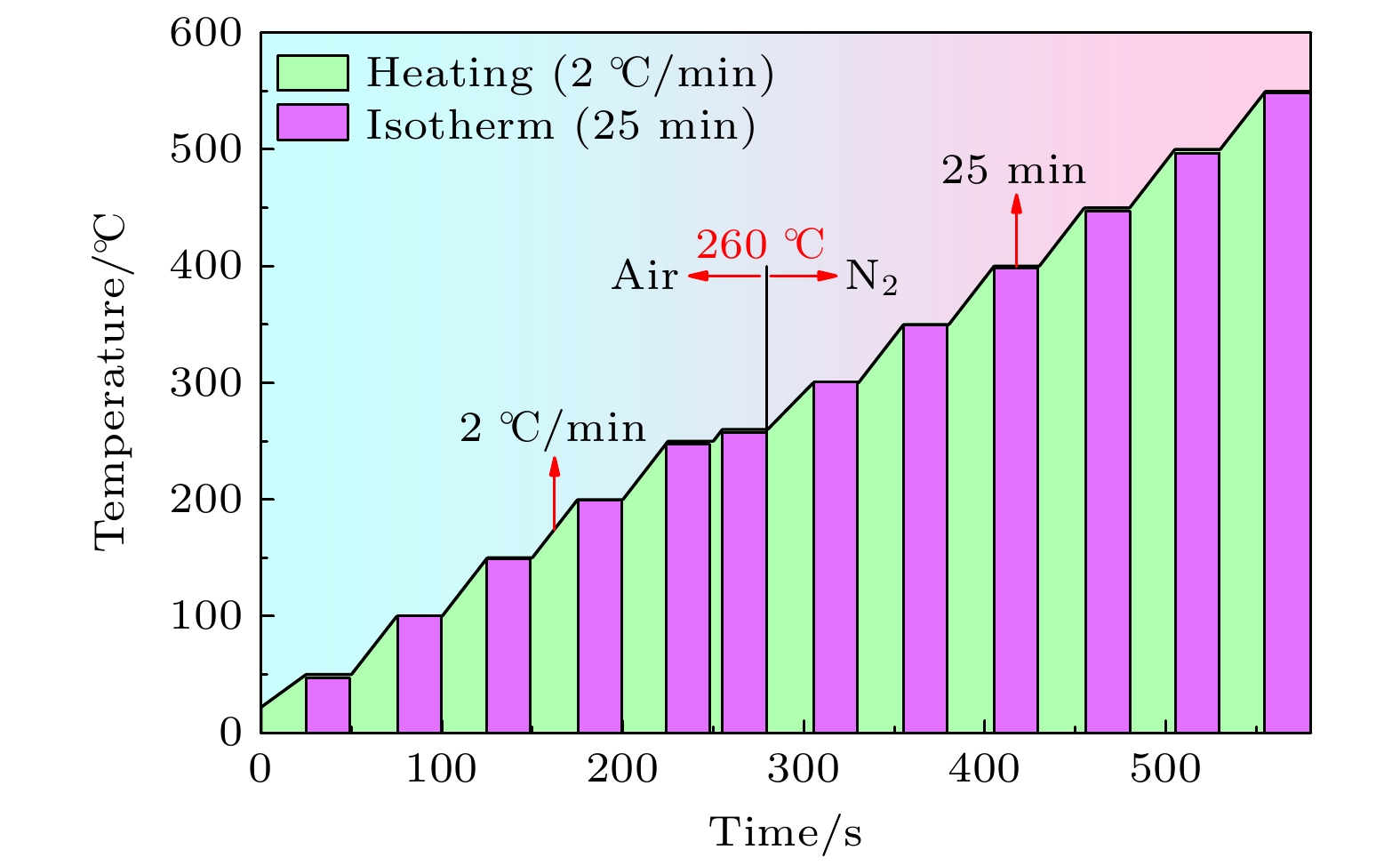
 下载:
下载:

